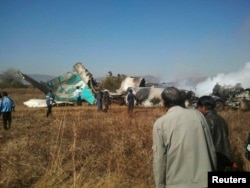Soe Moe Kyaw tried to keep his anxiety at bay as his malfunctioning plane burned off fuel to reduce weight for an emergency landing earlier this month.
“Don’t worry, don’t worry,” he had told a travel companion as the plane circled above Mandalay airport in Myanmar.
Then the pilot announced that his several attempts to lower the landing gear at the plane’s nose had failed; he was going to have to touch down without the front wheels.
As they descended towards the runway, the passengers adopted brace positions and waited for a rough landing. The plane’s nose scraped along the tarmac at high speed, but when the aircraft finally stopped everyone onboard was unharmed.
“It was an amazing landing, smoother than a normal landing,” Soe Moe Kyaw told VOA.
Myanmar’s fledgling aviation industry has seen a number of close calls recently. Just days before the 12 May Myanmar National Airlines accident, a Biman Bangladesh Airways flight came off the runway in bad weather at Yangon International Airport, injuring 20.
And a string of other accidents in recent years, including an Air Bagan crash in 2012 that killed two and injured 10, have threatened to damage passengers’ faith in the industry’s safety standards.
Myanmar’s aviation industry expanded rapidly after the start of sweeping economic reforms in 2010, but experts say authorities must tackle a lack of adequate infrastructure and skilled staff to ensure growth doesn’t come at the cost of safety.
“There will have to be a commitment to finance the training of personnel such as pilots, air traffic controllers and aircraft engineers to meet the demands of a booming industry,” said Professor Alan Khee-Jin Tan, an aviation law and policy expert at the National University of Singapore.
Despite the recent accidents, and the challenges posed by an underdeveloped economy, officials say it is unfair to brand Myanmar as unsafe for flying.
Ye Htut Aung, deputy director general at Myanmar’s Department for Civil Aviation, notes that the country scores just above the global average in a key safety ranking by the International Civil Aviation Organization (ICAO).
“And within the Asia Pacific region, our safety ranking is plotted right in the middle among 38 countries,” he added. Myanmar has an effective implementation score of 65.92 percent, while the global average is 65.51.
The ranking, though, is only part of the picture. It does not directly reflect data on accidents, for example, but instead measures how closely civil aviation authorities comply with more than 12,000 safety measures.
While an influx of new visitors to Myanmar in recent years saw airlines scramble to expand, things have since cooled off drastically, with several domestic airlines folding amid intense competition, an oversupply of seats and high fuel prices.
Financial difficulties like this, says Tan, could lead to “struggling airlines cutting corners on maintenance regimes in order to save on costs, thus leading to a race to the bottom in terms of safety standards.”
But Ye Htut Aung insists the industry’s recent woes have not impacted safety standards. “Is business bad in the airline industry? Yes, no doubt for the time being, but safety standards are above average.”
Soe Moe Kyaw said he doesn’t expect anything in the way of compensation from Myanmar National Airlines after the accident as he knows they’re struggling.
“For me, for most of us [on the flight], we don’t care about that because we have our lives. And the airline is not a rich airline.”
Myanmar National Airlines did not respond to emailed requests for comment. A Biman Bangladesh Airlines spokesperson told VOA he could not comment on the accident while an investigation was underway.
The string of recent accidents could, given the right conditions, serve as a wake up call for aviation authorities that helps improve standards in the long term, said Tan.
“Often, in the aftermath of an accident, public pressure on airlines and regulators shine a spotlight on unsafe practices. This could have positive longer-term results, even though the remedial steps taken must not be short-term fixes,” he said.
“They need to make systemic improvements so that airlines can regain the trust of the flying public.”






